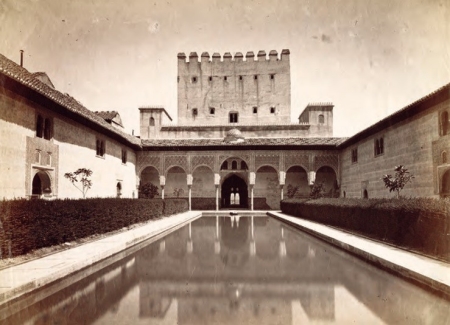The Alhambra has had many owners. After the Muslim kings were expelled in 1492, Isabel and Ferdinand took triumphant possession. With the Napoleonic invasion in 1808, the Alhambra passed briefly into the hands of the French, who repaired the roofs and restored the flow of water to the courtyards. But they also removed the pavement from the Court of the Lions and planted a garden that is widely (and mistakenly) believed to be an original Islamic
The site, which attracts two million visitors annually, appears well preserved. But some areas of archaeological interest have in fact been obliterated to create parking lots, and throughout the nineteenth and early twentieth centuries, large and small pieces of the architectural fabric were carried away by the very visitors who admired its semi-ruined beauty. In 1891 the wooden cupola in the Alhambra’s Partal Palace was removed by its owner and donated to a museum in Berlin, and museums around the world now possess tile, stucco, and marble fragments that were originally collected as souvenirs. Some of the changes to the palaces and grounds were wrought by preservationists themselves. The notebook of Leopoldo Torres Balbás, the architect who oversaw the most dramatic restoration of the palace, from 1923 to 1936, reveals that he inserted columns, redug pools, and reconfigured and replaced roofs (including the fanciful domelet seen in this photograph by Juan Laurent). In some areas, Torres Balbás removed the confusing jumble of ruined walls to enhance clarity and openness. These changes did not correctly reproduce the fourteenth-century state of the palace (incompletely known, in any case), but instead fulfilled Torres Balbás’ vision of how a fourteenth-century Islamic palace and its gardens ought to look.
Historical change is inevitable, but it seems invisible at the Alhambra, which was designated a UNESCO World Heritage Monument in 1984 on the grounds of the palace’s authenticity: “[N]either destroyed . . . nor changed by the alterations of radical restorations, the Alhambra and the Generalife appear to have escaped the vicissitudes of time.” The conservation experts who submitted the nomination to UNESCO saw the Alhambra as a window onto an intact past. Yet the past, as poststructural theory reminds us, is never delivered directly to the present, but rather arrives through the filter of our subjective excavation, perception, interpretation, and imagination. It is a sign and, as such, can be known only through representations, in the form of images, written descriptions, and even the palace itself, as it was creatively reproduced by its conservators to re-create what they believed it must have looked like in its golden age. The palace that we visit today—and that is often called upon to stand for the entirety of Hispano-Islamic history—is
The research I conducted at CASVA will contribute to a book and a future exhibition of prints, photographs, and objects that document the many phases of the Alhambra’s decline and restoration. The project does not propose to assert a correct restoration program for the
Members' Research Report Archive
Imagining the Alhambra
D. Fairchild Ruggles, University of Illinois, Urbana-Champaign
Paul Mellon Visiting Senior Fellow, May 23–July 1, 2011
The Alhambra, an Islamic complex of palaces that includes the Generalife, built in the thirteenth and fourteenth centuries on a hill overlooking Granada, Spain, figured prominently in the nineteenth-century romantic imagination. Travelers who marveled at the well-preserved garden courtyards and stuccoed halls experienced a piquant form of orientalism, in which the exotic was located close to home in Europe but emptied of its original inhabitants and thus available for repossession.

Jean Laurent, Alhambra, Court of the Myrtles and the Comares Tower. Department of Image Collections, National Gallery of Art Library, Washington